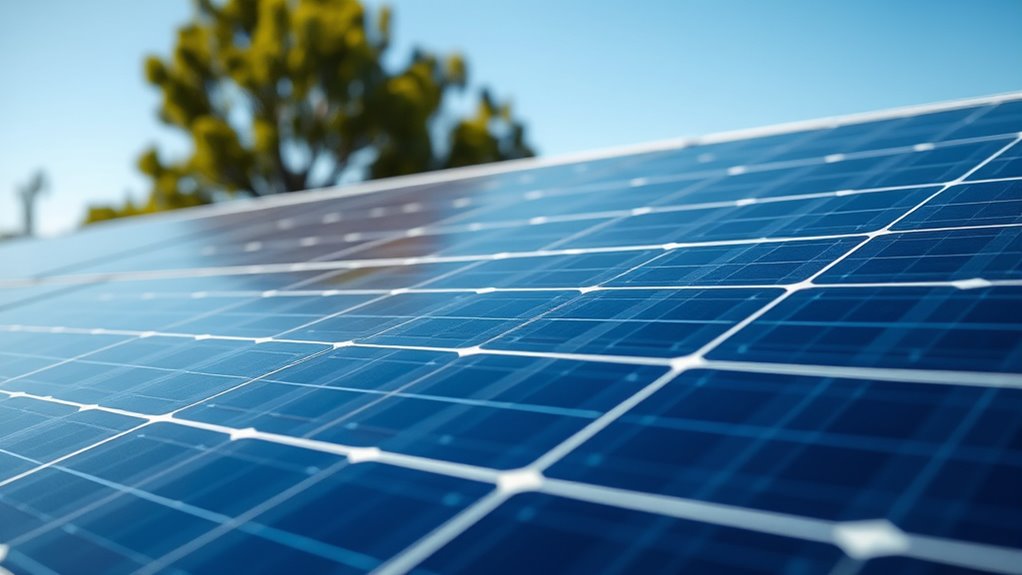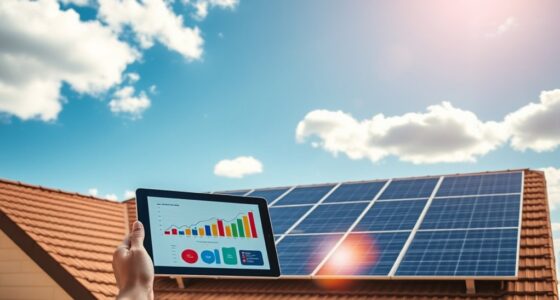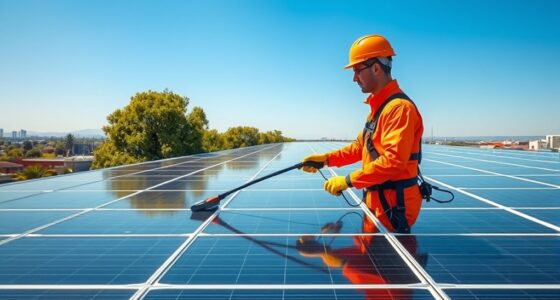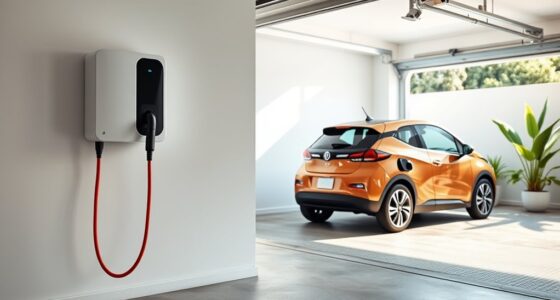Solar panels work by using semiconductor materials like silicon to convert sunlight into electricity through the photovoltaic effect. When sunlight hits the panel, photons dislodge electrons, creating an electric current. This direct current (DC) is then transformed by an inverter into alternating current (AC) for your home’s appliances. Factors like sunlight, temperature, and panel quality influence efficiency. If you’re curious about how all these components come together, you’ll find the details just ahead.
Key Takeaways
- Solar panels use semiconductor materials like silicon to absorb sunlight and generate electrical charges through the photovoltaic effect.
- When sunlight hits the panel, photons dislodge electrons, creating a flow of electric current within the cell.
- This direct current (DC) electricity is converted into alternating current (AC) by inverters for household use.
- The system’s efficiency depends on panel type, sunlight, temperature, and maintenance.
- Excess energy can be fed back into the grid or stored in batteries for later use.

Have you ever wondered how solar panels turn sunlight into electricity? It all starts with the photovoltaic cells, which are the core components of every panel. These cells are made from semiconductor materials, usually silicon, that have special properties allowing them to absorb sunlight efficiently. When sunlight hits the surface of a solar cell, the PV cell surface treatment helps collect electrons by enhancing their movement, making the process more effective.
Inside each solar cell, an electrical field is created by connecting multiple semiconductor layers in a specific way. When photons from sunlight strike the cell, they dislodge electrons, causing them to move. This movement generates an electric current that flows through the material. The flowing electrons create a flow of electricity, known as the photovoltaic effect, which is the fundamental process behind how solar panels produce power. The color of the light also affects how much energy is generated, with different wavelengths impacting efficiency.
Inside solar cells, semiconductor layers create an electric field that dislodges electrons, generating power through the photovoltaic effect.
The electricity generated initially is in direct current (DC) form, which isn’t suitable for most household appliances that rely on alternating current (AC). That’s where an inverter comes into play. It converts the DC electricity produced by the solar panel into AC, making it usable in your home. This conversion is essential for integrating solar energy into your household electrical system and for feeding excess energy back into the grid through a process called net metering.
Efficiency is an important aspect of solar panels, typically ranging between 15% and 22%. Various factors influence this, including the type of panel—monocrystalline or polycrystalline—sunlight intensity, temperature conditions, and the quality of the panel itself. High-quality panels tend to be more efficient and durable, and regular cleaning and maintenance can help maintain their performance over time.
Installing solar panels involves mounting them on your roof or on the ground, depending on space and sunlight exposure. Roof-mounted systems are common because they get direct sunlight most of the day. The process includes connecting the panels to an inverter and ensuring everything complies with local safety standards and regulations.
Once installed, your solar system can store energy in batteries for later use or connect to the grid, allowing you to sell excess power. Grid-tied systems often use smart technology to optimize energy use and can be integrated with home automation systems for better management. Overall, solar panels work by capturing sunlight, converting it into electricity through photovoltaic cells, and then making that power usable for your daily needs—cleanly, efficiently, and sustainably.
Frequently Asked Questions
What Maintenance Is Required for Solar Panels?
You need to keep your solar panels clean and well-maintained. Regularly remove dirt, leaves, and debris with a soft brush, especially after storms or dry spells. Inspect underneath for animal nests or debris. Schedule professional inspections every five to ten years and consider professional cleaning annually, which costs around $300. Keep an eye on your system’s performance with monitoring tools, and address any issues promptly to guarantee maximum efficiency.
How Long Do Solar Panels Typically Last?
When it comes to how long solar panels last, you’re in it for the long haul. Typically, they’re designed to work for 25 to 30 years, gradually losing about 0.5% efficiency each year. Even after that, many panels keep generating power—just not as much. Proper installation and maintenance can stretch their lifespan, so you get the most out of your investment for decades to come.
Can Solar Panels Work During Cloudy Days?
On cloudy days, your solar panels still work, but their efficiency drops to about 10-25%. The thick clouds block some sunlight, so production decreases, but you still generate electricity. You can store excess energy from sunny days in batteries for cloudy days, or rely on the grid for backup power. Overall, your panels remain useful, providing energy even when the weather isn’t perfect.
What Is the Initial Cost of Installing Solar Panels?
Thinking installing solar panels is cheap? Think again. The initial cost varies from about $3,500 to $55,000, with the average around $27,173. Larger, more efficient systems cost more upfront but save you money in the long run. Remember, incentives like the 30% federal tax credit can cut your bill. Factor in installation, panels, inverters, and labor, and you’re looking at a significant, but smart, investment.
Are There Any Government Incentives for Solar Panel Installation?
You might wonder if there are government incentives for solar panel installation. The good news is, several programs can save you money. The Residential Clean Energy Credit offers a 30% tax credit, reducing your tax bill. Plus, other local and state incentives could lower costs further. These incentives make going solar more affordable and help shorten your payback period, making solar a smarter investment for your home.
Conclusion
Now that you know how solar panels turn sunlight into electricity, you’re practically harnessing the power of the sun itself! With this knowledge, you can confidently make the switch to clean, renewable energy and save money. Imagine your home becoming a mini power plant, generating enough energy to outshine even the brightest star. It’s not just a smart choice — it’s a game-changer for your wallet and the planet. Embrace solar and watch your energy bills plummet!









